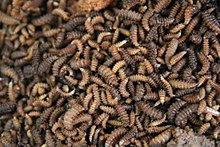Maggot



A maggot is the
Entomology
"Maggot" is not a technical term and should not be taken as such; in many standard textbooks of
Maggot-like fly larvae are of significance in ecology and medicine; among other roles, various species are prominent in recycling carrion and garbage, attacking crops and foodstuffs, spreading microbial infections, and causing myiasis. Maggots are also particularly important in forensic entomology because their development can help determine the time of death, particularly maggots in the Calliphoridae family.[7]
Uses
Fishing
Anglers use maggots usually commercially supplied to catch non-predatory fish. Maggots are the most popular
In North America, maggots have been used primarily as ice fishing bait; recently, however, anglers have started using them year-round.[citation needed] Artificial maggots for fishing, either in natural or fluorescent colors, have been developed and are used for trout, panfish, or salmon species.[9]
Medical treatment
Live maggots of certain species of flies have been used since antiquity for wound debridement. Larvae of calliphorid flies of the species Lucilia sericata are widely used.[10] Not all species are safe and effective; use of the wrong species would invite pathological myiasis.[11]
In controlled and sterile settings overseen by
Acceptance by healthcare workers has inhibited acceptance, but a supplier of maggots said in 2022 that she had noticed significantly more acceptance over the four years she had worked in the field. Acceptance among patients is high.[14]
Forensic science
The presence and development of maggots on a
Maggots are useful as well in entomotoxicology, in determining the presence of drugs in a corpse's system. Maggots bioaccumulate xenobiotics (substances, drugs, metals, etc.) from tissue and bone, therefore allowing entomologists to determine if xenobiotics, most commonly drugs, were present in the body before death.[16] This is useful in concluding a cause of death in many different cases including overdoses and poisonings. It also helps in determining manner of death including suicide or homicides.[17] Maggots are able to bioaccumulate substances from fresh corpses, as well as fully decomposed skeletonized bodies.[18] Data and resources on entomotoxicology are sparse as it is a relatively new field of study.[19] The knowledge of how the drug or substance effects the development of maggots is necessary as some drugs such as cocaine and methamphetamine are proven to accelerate the development of larvae, whereas opiates are shown to decelerate said rate.[20]
Behaviours

As with
When maggots turn into adult flies and start the life cycle over, numbers will
See also
- Caterpillars
- Polychaete
- Worm
- Maggot farming
- Myasis
References
- ^ "Definition of MAGGOT". merriam-webster.com. Retrieved 29 January 2017.
- ^ Comstock, John Henry, An Introduction to Entomology. Comstock publishing, 1930.
- ISBN 0-412-61390-5.
- ^ Jardine, N. K. The Dictionary of Entomology. 1913.
- ^ Smith, John. B. Explanation of terms used in entomology. Brooklyn Entomological Society, 1906.
- ISBN 978-1-77085-100-9.
- ISBN 978-0-521-01957-6.
- ^ "MAGGOTS – THE PERFECT FISHING BAIT". Angling Times. Retrieved 6 September 2022.
- ^ Lance (9 November 2021). "Pink Maggots for Fishing Bait". Kokanee Fishing. Retrieved 14 March 2023.
- PMID 20144365.
- ^ James, M. T. (1947). The Flies That Cause Myiasis in Man. Washington D.C.: U.S. Dept. of Agriculture.
- S2CID 39079130.
- ^ Ngan, Vanessa (2005). "Maggot debridement therapy". DermNet.
- ^ Tait, Amelia (26 February 2023). "Medieval medicine: the return to maggots and leeches to treat ailments". The Guardian.
- PMID1539937.
- ^ "FORENSIC ENTOMOLOGY : THE USE OF INSECTS". www.sfu.ca. Retrieved 7 April 2023.
- PMID 21299858.
- PMID 1797976.
- PMID 1797976.
- ^ Magni, Paola; Conversation, The. "Flies, maggots and methamphetamine: How insects can reveal drugs and poisons at crime scenes". phys.org. Retrieved 7 April 2023.
External links
- Diptera at Curlie
